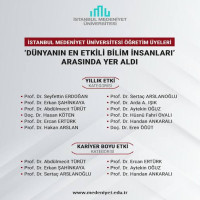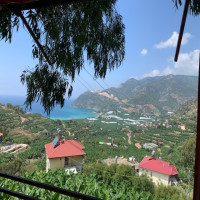Letter to Editor
Clinical Research
Review
Case Report
Issue Reviewers

Graduated from Istanbul University Cerrahpasa Medical Faculty, Ph.D. in Akdeniz University School of Medicine worked in Universita Degli Studi di Siena in Italy and currently works as a lecturer. His research interests are based on neuroanatomy, neurochemical anatomy, dissection based cadaver studies, cadaver dissection, skull base, skull, bones. He is also involved in teaching master and doctorate students in the field of Neuroscience PhD.



Aim & Scope
Aim
Scope
Author Guidelines
Instructions to Authors
Article Acceptance
Submission of articles to the journal is carried out on the "DergiPark" website (https://dergipark.org.tr/tr/journal/3859/submission/step/manuscript/new ). Articles sent other than of this system are not taken into consideration. Articles are evaluated in terms of aim of the journal, compliance with ethical and scientific principles, accuracy, timeliness and usability by the target readership.
The articles submitted to the journal must not have been published in another electronic or printed journal before. The compliance of the articles with the laws and ethical rules and the accuracy of the information are the responsibility of the authors. The financial and legal responsibility of the text, tables, figures, pictures and all kinds of content used in the articles, which may be subject to national and international copyrights, belongs to the authors. No fee is paid to the authors for the published articles.
All authors are required to indicate their ORCID numbers during the article submission process. The ORCID account is free and can be created at “ https://orcid.org/register “.
Review process
Manuscripts submitted to the journal are first reviewed in terms of journal standards. Manuscripts that do not comply with the format requested by the journal are returned to the Corresponding Author without further evaluation. All articles are first evaluated by the editor-in-chief and the editor; The article is sent to the relevant editorial board member for later review. The manuscript that passes the evaluation of the relevant section editor is sent to at least two reviewers. The evaluation period of the reviewers is 21 days. The reviewers who evaluate the article upload the "Reviewer Evaluation Form" to the system, this form is evaluated by the relevant editor. All manuscripts are subject to editorial review and correction; when necessary, the authors may be asked to answer some questions and complete the deficiencies. The result of the evaluation period can be accepted, minor revision, major revision or rejection decision. The article that is decided to be published in the journal is taken into the printing process; at this stage, it is subjected to detailed control and review for the accuracy of all information; the final form is prepared before publication and submitted to the authors' control and approval.
Copyright Transfer Form
The authors, starting from the evaluation of the articles, transfer all their copyrights to the journal within the framework of national and international laws. The ‘’Copyright Transfer Form’’ signed by all authors must be uploaded to the system during the submission of the articles. Authors who will send an article to this journal for evaluation should sign the "Copyright Transfer Form" and scan it and upload it to the system. https://dergipark.org.tr/tr/pub/izmirtip/page/13523
Authorship
Each person identified as an author in the article must meet the criteria for authorship recommended by the International Committee of Medical Journal Editors (ICMJE) (www.icmje.org). Journal Ethical Rules are detailed in the Editorial Policies Section.
Conflicts of Interest
Individuals and organizations from whom all kinds of aid and other funding(s) for research are received should be declared to the editorial board, and the ICMJE Potential Conflicts of Interest Notification Form should be filled in and uploaded to the system in order to explain the conflict of interest situations. For detailed information and declaration of interest, the Conflict of Interest Form can be examined (http://icmje.org/conflicts-of-interest/).
Preparation of the Article
The written language of the Journal of Izmir Faculty of Medicine is Turkish and English. Manuscripts should be written double-spaced, in 12-point (Times New Roman) font, aligned to the left. There should be 2.5 cm distance at the margins of the page and page numbers should be placed in the lower right corner of each page.
Articles must comply with the Standards for Articles Submitted to Biomedical Journals (http://www.icmje.org) determined by the "International Board of Editors of Medical Journals". The maximum number of words-tables-shapes-authors-resources for the articles is shown in Table 1. The main text was taken as the basis for word limitations. Summary and References sections are outside of the limitation.
Table 1. Limitations for each manuscript type
| Type of manuscript | Word limit | Abstract word limit | Reference limit | Author limit | Table limit | Figure limit |
| Original Article | 2500 | 350 | 35 | Unlimited | 6 | Total of 10 images |
| Systematic Review Article | 5000 | 350 | 50 | 6 | 6 | Total of 15 image |
| Case Report | 1500 | 350 | 15 | 4 | No tables | Total of 8 images |
| Technical Note | 2500 | 350 | 15 | 4 | No tables | Total of 8 images |
| Letter to the Editor | 350 | No Abstract | 5 | 4 | No tables | Total of 2 images |
Articles will be accepted in Microsoft Word file format (text file with .doc or .docx extension). Authors should prepare their articles to include the following titles;
a. Title page:
The title page must be submitted as a separate file. It should include the title of the article not exceeding 150 characters, the short title not exceeding 50 characters, the names of the authors, their academic titles, ORCID IDs, the institutions they work for, the grant or funding resources used in the study. On this page, the name, full address and e-mail address of the corresponding author should be given.
It should be reported that the articles submitted to journal for publication have not been published elsewhere before or are not under review by another journal at the same time. If the article was created from a thesis or a part of the thesis, it should be stated. Whether the content of the manuscript was presented in a scientific meeting before, and if it was, the name, date and place of the meeting should be stated.
b. Abstract:
For original research articles and systematic reviews/meta-analyses, it should include an abstract of no more than 350 words outlining the work. Abstract section should be structured under the sub-headings of; purpose, materials and methods, results, and conclusion. Case reports should be structured under the sub-headings of; purpose, case(s) presentation and results. For technical notes, it is not necessary to divide the abstract into sections. Abstract sections should be written in both Turkish and English. Subheadings for the English abstract should be in the form of "aim, materials and methods, results, and conclusion".
c. Keywords:
Below the abstract, three to five keywords should be chosen for topic indexing that are thought to best represent the article. Abbreviations should not be used in keywords. Keywords should be separated by semicolons and written in both Turkish and English. Keywords should be selected from the database of Index Medicus Medical Subject Headings (https://www.nlm.nih.gov/mesh/MBrowser.html).
d. Main Text:
Original research articles and systematic reviews/meta-analyses should be structured with subheadings of introduction, material and methods, results and discussion. Abbreviations should be explained at their first appearance in the text, in each table, picture and figure. If a company name is to be specified, the name and address (city, country) of the manufacturer should be given. References, tables and illustrations should be cited in the main text and numbered sequentially. Case reports should be structured under the headings of introduction, case(s), discussion.and technical notes under the headings of introduction, technical note, and discussion. Before writing the references for research articles, case reports and technical notes, any support received , any conflict of interest with the authors, and contributions made by them to the study should be stated indicating the initials of the authors' names , surnames, and the subject they contributed to. “Acknowledgment” letter to public or private institutions that contributed to the research or the preparation of the article; should appear at the end of the article, before references.
e-References:
References should be written double-spaced at the end of the main text. The latest and the most up-to-date publications and national publications should also be preferred when citing references. References in the main text should be indicated in parentheses at the end of the sentence. The author(s) are responsible for the accuracy of the references. When referencing six or fewer authors, all authors should be listed. If a cited publication is realized by more than six authors, then , after the first six authors the abbreviations of “ve ark.”, and “et al.” should be written for references retrieved from sources published in Turkish, and English, respectively. If more than one reference is cited, a comma must be placed between the reference numbers. If more than two consecutive references are used together, a hyphen “-“ must be placed between the smallest and largest reference numbers specified (for example (12-17)).
References should be prepared according to the rules of “Uniform Requirements for Manuscripts Submitted to Biomedical Journals” developed by the “International Committee of Medical Journal Editors (ICMJE)”. Examples of references prepared in this context are given below. For unspecified source formats, the website http://www.nlm.nih.gov/bsd/uniform_requirements.html should be used as a guide. Each reference should be numbered according to the order of its first appearance in the text and should be indicated in parentheses at the end of the sentence. Titles of the journals should be abbreviated in accordance with Index Medicus. For the abbreviations of the titles of the journals, the list of journals indexed in Index Medicus or http://www.nlm.nih.gov/tsd/serials/lji.html may be consulted. Abbreviations are not used for the journals that are not included in the Index Medicus. As references , published or "in press" articles, accepted thesis studies, books, book chapters, papers presented in national or international meetings can be used. References should be written as indicated below.
Scientific Journals: DelGaudio JM. Steroid inhaler laryngitis: dysphonia caused by inhaled fluticasone therapy. Arch Otolaryngol Head Neck Surg. 2002;128:677-81.
Online Journals: Mertcan A. Pathological analysis of tendon healing. Orthop Pat. Published online May 7, 2022. doi:10.1047/ım2264
Books: El-Naggar AK, Chan JKC, Grandis JR, Takata T, Slootweg PJ. WHO Classification of Head and Neck Tumours. 4th ed. Lyon: IARC; 2017.
Book chapters: Folkman J: Tumor angiogenesis. In Bast Jr RC, Kufe DW, Polock RE,Weichselbaum RR, Holland JF, Frei E (eds). Cancer Medicine. 5th ed. London, B.C. Decker Inc.; 2000. p.132-52.
Papers presented at a meeting: Günaydın B. Does anterolateral ligament injury change the treatment option in patients with partial ACL tears?Paper presented at: 20th EFORT Congress 5-7 June 2019 Lisbon, Portugal. BioScifentifica; 2019:72-3.
Dissertations:: Şahin BŞ. Akut koroner sendrom tanısıyla hastaneye yatırılan hastaların hastane izlemi sırasında ve taburculuk sonrasında sigara içme davranışlarının değerlendirilmesi. İzmir; Sağlık Bilimleri Üniversitesi İzmir Tıp Fakültesi; 2021.
f.Tables:
All tables should be numbered with Arabic numerals according to their order of use in the text and should be shown in parentheses in the text. Tables should not be included in the main text, but should be uploaded to the system as a separate file. Below the table; explanations and abbreviations used in the table should be written. The information presented in the tables should not be a repetition of the data in the text and should support the main text.
g. Pictures and Figures:
All pictures should be numbered with Arabic numerals according to their order of use in the text and should be shown in parentheses in the text. Pictures must be submitted as separate files, in TIFF or JPEG format. Bold and thin arrows, arrowheads, etc., may be used to support explanations in images. Unless necessary, writing on the pictures should be avoided. Submitted images must have a minimum resolution of 300 dpi and 1200x960 pixels. Pictures and figures should not be included in the main text and should be uploaded to the system as a separate file.
h. Subtitles of Pictures, and Figures
Subtitles prepared for all pictures and figures should come after the tables in the main text and should be stated briefly and concisely. Symbols and abbreviations used in the figures should be explained.
SUBMISSON OF THE MANUSCRIPT
Articles can only be submitted via the journal's website (https://dergipark.org.tr/tr/journal/3859/submission/step/manuscript/new ). The files should be uploaded to the system in the following order ; Author Liability and Copyright Transfer Form, Title page, Main Text (with abstract) and Figures.
Ethical Principles and Publication Policy
Being aware of the need for easy access to information in order to advance scientific studies, Journal of Izmir Faculty of Medicine, supports the open access initiative of the peer-reviewed journal literature included in the Budapest Open Access Declaration and presents all published articles free of charge in an environment where everyone can read and download it. In this declaration, open access means that “scientific literature can be accessed, read, saved, copied, printed, scanned, linked to the full text, indexed, transferred to software and used for any legal purpose without financial, legal and technical barriers through the Internet”. used meaning. Considering the role of knowledge sharing in the advancement of science, open access is of great importance for researchers and readers. For this reason, the articles in this journal can be used as long as the author and the original source are cited. No permissions are required from authors or publishers. Articles in this journal are available across search engines, websites, blogs, and other digital platforms.
These open access policies, which were accepted on 12 September 2012 and adopted by our editorial board, can be accessed at http://www.budapestopenaccessinitiative.org/boai-10-translations/turkish-translation.
No subscription fee, publication fee or similar payment is requested for accessing the articles published in Journal of Izmir Faculty of Medicine.
Authors can store submitted, accepted and/or published versions of their articles in their preferred archives.
Creative Commons
A Creative Commons license is a type of public copyright license that allows free distribution of a copyrighted work or work. When an author wants to give the right to share or make changes to the work he has created, he uses the CC license.
Our journal approves the "Creative Commons Attribution License (Attribution-NonCommercial-NoDerivatives 4.0 International CC BY-NC-ND)" license for all published articles.
This license allows other authors to use your work in their own work for non-commercial purposes and attribution to your work.
Open access is an approach that reinforces interdisciplinary development and encourages collaboration between different disciplines. Therefore, the JOURNAL contributes to its field by offering more access to its articles and a more transparent review process.
Price Policy
no fee.






